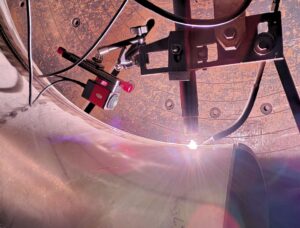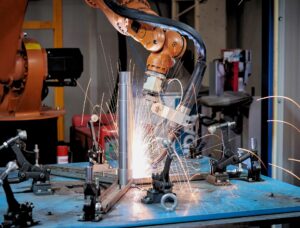In industries like oil and gas, power generation, and heavy manufacturing, cladding is a critical process used to protect base materials from wear, corrosion, and extreme temperatures. Overlay welding, a type of cladding process, involves applying a layer of material to a substrate to improve its properties. While this process offers tremendous benefits, ensuring the overlay weld quality is essential to achieving the desired performance and durability. Welding cameras are playing an increasingly important role in cladding applications by providing real-time monitoring and detailed visual feedback of the welding process. By using welding cameras to track the overlay weld quality, operators can make immediate adjustments, ensuring superior results and reducing the likelihood of defects. Let’s dive into how welding cameras are enhancing the cladding application and helping to maintain consistent overlay weld quality.
1. Real-Time Monitoring for Overlay Weld Precision
Overlay welding requires precise control over various parameters, including heat input, travel speed, and material deposition. Welding cameras provide a real-time visual of the welding arc and bead, helping operators closely monitor the process. This continuous feedback ensures that the overlay material is applied evenly and consistently, avoiding issues such as undercut, porosity, or inadequate bonding between the overlay and the base material.
How It Helps:
- Monitor the arc welding image in real time to ensure proper heat input and weld pool formation
- Track the quality and consistency of the overlay weld bead during the cladding process
- Make immediate adjustments to welding parameters based on the visual feedback from the camera
2. Enhanced Detection of Common Overlay Weld Defects
Overlay welding can be prone to several defects, including porosity, slag inclusion, and undercut, which can compromise the performance of the cladding. Welding cameras offer a significant advantage in detecting these defects early in the welding process, allowing operators to address them before they cause permanent damage.
Benefits:
- Detect weld defects such as porosity and slag inclusion as soon as they appear in the overlay weld
- Prevent defects from spreading, minimizing the need for rework and repairs
- Ensure proper fusion between the base material and the overlay layer, preventing bonding issues
3. Improved Process Control and Consistency
Achieving consistent overlay welds is critical for the success of cladding applications. Welding cameras help monitor the entire welding process, ensuring that each pass is uniform and that the cladding material is applied according to the specified standards. By providing operators with a clear visual of the weld bead, welding cameras ensure that the process remains within optimal parameters throughout the project.
How It Helps:
- Maintain consistent bead size and overlay thickness across the entire weld joint
- Monitor heat input, ensuring the overlay material is properly fused without excessive heat that could damage the base material
- Optimize welding speeds and material deposition rates based on camera feedback
4. Optimizing Heat Control for High-Quality Overlays
One of the challenges in overlay welding is managing the heat input to prevent issues like cracking or distortion in the base material. Welding cameras allow operators to track the arc and heat distribution during the cladding process, providing a clear picture of how heat is being applied and how it is affecting the weld pool.
How It Helps:
- Visualize heat zones and make real-time adjustments to avoid overheating or underheating the material
- Ensure uniform heat distribution for strong, durable bonds between the base material and the overlay
- Track the welding arc’s behavior, allowing for precise adjustments to avoid issues like burn-through or weak fusion
5. Increased Efficiency and Reduced Downtime
The overlay welding process can be time-consuming, and any interruptions due to defects or the need for corrections can lead to significant downtime. By using welding cameras, operators can detect issues early and make necessary adjustments without having to stop the process for extensive inspections. This leads to improved efficiency, faster turnaround times, and reduced production delays.
Efficiency Benefits:
- Prevent production delays by addressing issues such as misalignment, porosity, or slag inclusion in real time
- Eliminate the need for manual inspections or frequent stoppages during the cladding process
- Improve overall efficiency by optimizing welding parameters based on continuous monitoring from the welding camera
6. Data Recording for Process Optimization and Quality Assurance
Welding cameras provide valuable data that can be stored and analyzed to improve the overall cladding process. The ability to record high-quality visuals of the weld arc and overlay material allows for better process optimization, troubleshooting, and long-term quality assurance. Operators can review the recorded data to identify patterns and areas for improvement, ensuring that future cladding projects run more smoothly.
How It Helps:
- Capture arc welding images and process data for future reference and analysis
- Analyze visual data to identify areas where welding parameters can be fine-tuned for improved overlay weld quality
- Use historical data to optimize cladding processes for increased consistency in future projects
7. Remote Monitoring using Welding Cameras for Cladding Application for Better Control and Safety
Cladding applications often take place in difficult-to-reach or hazardous environments, such as offshore platforms, high-temperature operations, or confined spaces. Welding cameras provide remote monitoring capabilities, allowing operators to track the welding process from a safe distance, improving both control and safety.
Safety Benefits:
- Reduce the need for welders to be in close proximity to the welding arc, minimizing exposure to heat and fumes
- Use welding visual inspection techniques to monitor the overlay welding process from a safe location
- Improve overall safety during cladding projects, especially in hazardous or challenging environments
Conclusion: Welding Cameras and Cladding Application
The quality of overlay welds in cladding applications is critical for ensuring the longevity and performance of materials exposed to harsh conditions. Welding cameras offer a comprehensive solution for monitoring and adjusting the overlay welding process, ensuring that every weld meets the highest standards. With real-time feedback, defect detection, heat control, and process optimization, welding cameras help fabricators achieve superior cladding results and improve overall welding efficiency.
Whether you’re working on oil and gas pipelines, power generation equipment, or heavy machinery, welding cameras provide the visibility and control needed to ensure flawless overlay welds. Mecaweld offers state-of-the-art welding camera systems to help you monitor and improve the quality of your cladding applications. Contact us today to learn more about how our welding inspection tools can optimize your overlay welding processes.



